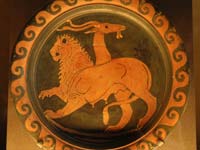There's a glut of awesome science coming out towards the end of this week and not much at the start, so I'm sticking the Revisited post up early (it's usually on a Saturday) to clear the schedule later.

![]() Imagine you are a man who has just learned, through a genetic test, that your son carried your brother's genes instead of your own. You might well have some stern words to exchange with your partner. But if you were a marmoset, this would all be part and parcel of life.
Imagine you are a man who has just learned, through a genetic test, that your son carried your brother's genes instead of your own. You might well have some stern words to exchange with your partner. But if you were a marmoset, this would all be part and parcel of life.
 In a striking new study, scientists from the University of Nebraska have shown that marmosets inherit genes not only from their parents, but from their monkey uncles and aunts too. Each individual is a genetic chimera.
In a striking new study, scientists from the University of Nebraska have shown that marmosets inherit genes not only from their parents, but from their monkey uncles and aunts too. Each individual is a genetic chimera.
In Greek mythology, the chimera was a monstrous mixture of lion, goat and dragon (see below). But in the world of genetics, the word has much less grotesque overtones - it simply means an animal whose body contains two or more groups of cells with distinct sets of genes.
Most species of marmoset give birth to non-identical twins. At first, each embryo is surrounded by its own protective sac Â- the chorion - but after the first month of development, these sacs fuse together.
Blood vessels connect the developing embryos and embryonic stem cells can travel between them. These swapped stem cells can eventually set up groups of cells in one twin that contain the other's genes. So the majority of marmosets have tissues descended from the stem cells of their siblings.
Up till recently, scientists thought that this chimerism only applies to blood cells. But Corinna Ross and colleagues proved otherwise. They took DNA fingerprints of different organs from 36 twin pairs of Wied's marmosets (Callithrix kuhlii) from fifteen different families. About three in four pairs had tissues that were genetic matches for their twins - a clear sign of chimerism.
 Every single tissue type examined, including brain, skin, hair, muscle, liver and more, was chimeric in at least one set of twins. But the big surprise was over half of the male marmosets had chimeric sperm. Which means that these men were occasionally and unwittingly fertilising females with their sibling's genes.
Every single tissue type examined, including brain, skin, hair, muscle, liver and more, was chimeric in at least one set of twins. But the big surprise was over half of the male marmosets had chimeric sperm. Which means that these men were occasionally and unwittingly fertilising females with their sibling's genes.
Ross found that parents from a third of the families examined passed on some genes to their children that they had themselves inherited from their brothers or sisters. She even speculates that a marmoset mother might be able to pass on a Y chromosome to her children if she was given one by her twin brother.
This unique way of passing on genes has many interesting consequences for marmoset siblings and parents. For a start, it means that marmoset brothers and sisters are more closely related to each other than human siblings are.
On average, a pair of human siblings (identical twins aside) shares 50% of their genes. But because marmoset twins often pass entire cell lines across to each other, some of their body parts carry the exact same genes. So on average, marmoset twins have more genes in common than human ones.
This increased relatedness could explain the strong social bonds that unite marmoset families, where parents and older siblings co-operate looking after younger ones. Marmoset fathers are particularly known in the mammal world for their devotion to their children, and again, chimerism might explain why.
Like many other animals, marmosets use certain chemical odours to work out whether a child is related to them, allowing them to care for their own genetic legacy and no one else's. Ross speculates that chimeric children give off both their own odours and those of their twin, giving male marmosets even stronger evidence of their fatherhood. The purpose of chimerism then, could be to allow marmoset children to pass paternity tests with flying colours.
Indeed, Ross found that they spent more time caring for their children if they were chimeric and spent twice as much time giving them piggy-back rides.
So family trees in the marmoset world are strange ones. It is a world where individuals are a fusion of their own bodies and their sibling's and where mothers can give birth to their own nephews and nieces. Thankfully, they don't have to worry about geneaologies...
Reference: Ross, French & Orti. 2007. Germ-line chimerism and paternal care in marmosets (Callithrix kuhlii). PNAS 104: 6278-6282.
More from Not Exactly Rocket Science on sex and genes:


Nice article, as always. Chimerism is there too in chemistry and pharmacology. Chimeric molecules exhibit handedness and are used for drug development.